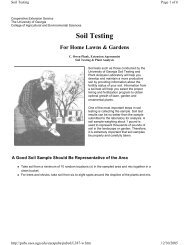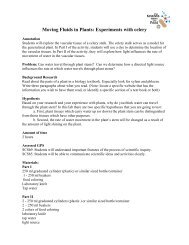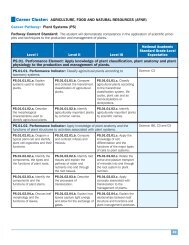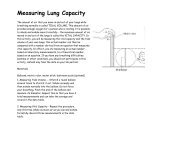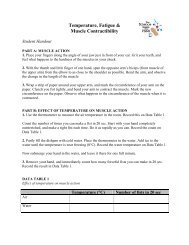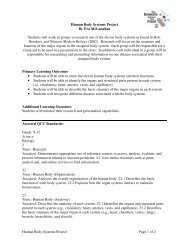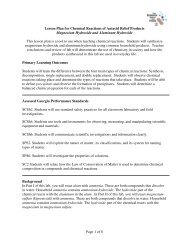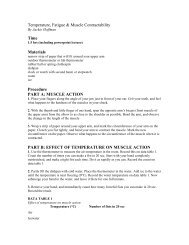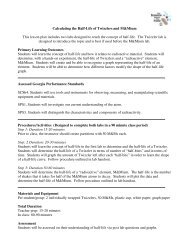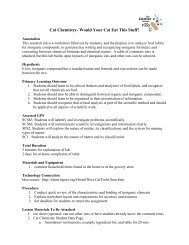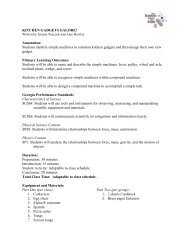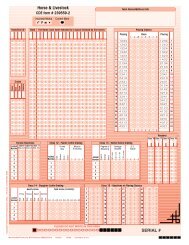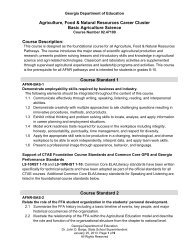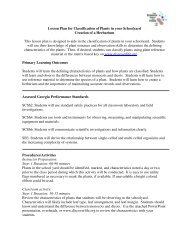Tropical Fruit Gelatin Lab Page 1 of 8 Tropical Fruit Gelatin Lab By ...
Tropical Fruit Gelatin Lab Page 1 of 8 Tropical Fruit Gelatin Lab By ...
Tropical Fruit Gelatin Lab Page 1 of 8 Tropical Fruit Gelatin Lab By ...
Create successful ePaper yourself
Turn your PDF publications into a flip-book with our unique Google optimized e-Paper software.
<strong>Tropical</strong> <strong>Fruit</strong> <strong>Gelatin</strong> <strong>Lab</strong><br />
<strong>By</strong> Eva McLanahan<br />
This lesson explains the science behind the fresh pineapple warning on JELL-O boxes. The<br />
warning advises against the use <strong>of</strong> certain fresh or frozen fruits because they will not allow the<br />
gelatin to solidify. Students will explore the differences when fresh, frozen, and canned<br />
pineapple are used to make gelatin. This lesson may be taught as a hands-on activity or as a<br />
classroom demonstration.<br />
Primary Learning Outcomes<br />
Students will see first hand the difference between the use <strong>of</strong> fresh, frozen, and canned pineapple<br />
in gelatin. They will develop a hypothesis as to why the fresh and frozen pineapple did not allow<br />
the gelatin to solidify. Ultimate learning outcome is that <strong>of</strong> enzyme denaturation at high<br />
temperatures, which occurs during the canning process, and the idea <strong>of</strong> optimum temperatures<br />
for enzyme function.<br />
Additional Learning Outcomes<br />
Students will implement the scientific method at varying levels depending on the modifications<br />
chosen for the experiment.<br />
Assessed QCC Standards:<br />
Grade: 9-12<br />
Science<br />
Biology<br />
1<br />
Topic: Science Process Skills, and <strong>Lab</strong>oratory Safety<br />
Standard: Uses terms and processes employed in scientific research. 1.1. Demonstrates<br />
pr<strong>of</strong>iciency in the use <strong>of</strong> science process skills in laboratory and/or field activities involving<br />
observation, classification, communication, metric measurement, prediction, inference,<br />
identifying variables, formulating hypotheses, controlling variables, making operational<br />
definitions, designing investigations, experimenting, collecting qualitative and/or quantitative<br />
data, constructing a data table, graphing, analyzing, and interpreting data and/or drawing<br />
conclusions. 1.2. Produces written reports <strong>of</strong> laboratory and/or field activities in accepted<br />
formats and use precise language for presentations <strong>of</strong> procedure, tables <strong>of</strong> data, graphs, analytical<br />
methods, results, and analyses <strong>of</strong> error. 1.3. Uses laboratory equipment to conduct safe and<br />
accurate laboratory work. 1.4 Demonstrates the proper care and use <strong>of</strong> the microscope and how<br />
to prepare slides.<br />
3<br />
Topic: Nature <strong>of</strong> Biology<br />
Standard: Explains the significance <strong>of</strong> biology (e.g., impact on daily life). 3.1 Defines biology<br />
and major divisions (e.g., botany and genetics). 3.2 Explains the use <strong>of</strong> biology in daily life.<br />
<strong>Tropical</strong> <strong>Fruit</strong> <strong>Gelatin</strong> <strong>Lab</strong> <strong>Page</strong> 1 <strong>of</strong> 8
6<br />
Topic: Biochemistry (Chemical Concepts)<br />
Standard: Recognizes that life has a chemical basis. 6.1 Demonstrates an understanding <strong>of</strong> basic<br />
chemical principles, (e.g., phases <strong>of</strong> matter, atomic structure, bonding, acids, bases). 6.2<br />
Identifies the elements <strong>of</strong> the earth’s atmosphere and crust that comprise living cells. 6.3<br />
Explains the special role <strong>of</strong> water in living systems. 6.4 Describes the four basic types <strong>of</strong> organic<br />
compounds (carbohydrates, lipids, proteins, and nucleic acids) and their functions in the cell.<br />
Procedures/Activities<br />
Step: 1 Duration: 40 minutes to 60 minutes depending on difficulty<br />
<strong>Lab</strong> procedures should be conducted as stated in the <strong>Tropical</strong> <strong>Fruit</strong> <strong>Gelatin</strong> <strong>Lab</strong> attached.<br />
Modifications can be made based on experimental design capabilities <strong>of</strong> your class and their<br />
level <strong>of</strong> enzyme knowledge. (Note: The students can each prepare gelatin at their lab station or<br />
the teacher can prepare several packs <strong>of</strong> gelatin to save time. Prepare gelatin as stated on<br />
package. Prepared gelatin can be kept hot on a hot plate until ready for use.)<br />
Web Resources for Step 1<br />
Title: Dole Plantation -- Hawaii<br />
URL: http://www.dole-plantation.com/<br />
Annotation: This website will help with background information on pineapple processing<br />
should you choose to describe this process in your classroom.<br />
Title: Everything about digestive enzymes<br />
URL: http://www.enzymestuff.com/index.htm<br />
Annotation: This website will help with explaining the specifics <strong>of</strong> digestive enzymes and<br />
background information to supplement textbooks.<br />
Title: Bromeliflorae Background and Information<br />
URL: http://www.ucmp.berkeley.edu/monocots/bromeliflorae.html<br />
Annotation: University <strong>of</strong> California, Berkeley informative website on the Bromeliaceae family.<br />
Attachments for Step 1<br />
Title: <strong>Tropical</strong> <strong>Fruit</strong> <strong>Gelatin</strong> <strong>Lab</strong> Handout<br />
FileName: <strong>Tropical</strong> <strong>Fruit</strong> <strong>Gelatin</strong> <strong>Lab</strong>.doc<br />
Description: This is the lab handout to complete the <strong>Tropical</strong> <strong>Fruit</strong> <strong>Gelatin</strong> <strong>Lab</strong>. Students will<br />
find background, materials, procedure, results table, and discussion/conclusion questions to<br />
answer.<br />
Materials and Equipment (Student)<br />
4 test tubes, fresh pineapple, frozen pineapple, canned pineapple (chunky), powdered gelatin,<br />
water, beaker or glass measuring cup, ice water bath, test tube rack, plastic knife, Sharpie, 50 mL<br />
beaker<br />
<strong>Tropical</strong> <strong>Fruit</strong> <strong>Gelatin</strong> <strong>Lab</strong> <strong>Page</strong> 2 <strong>of</strong> 8
Materials and Equipment (Teacher)<br />
hot plate or microwave for gelatin preparation, 2-400mL beakers, water, spoon<br />
Total Duration<br />
40-60 minutes<br />
Assessment<br />
<strong>Lab</strong> report and/or discussion questions.<br />
Extension<br />
This lab can be modified based on the amount <strong>of</strong> time available to execute the lab and the<br />
amount <strong>of</strong> information to disclose to the students before completing the exercise. Many may<br />
wish to perform this experiment as a simple demonstration and lead into a discussion about<br />
enzymes. Others may wish to either use the lab as appears in this lesson plan, or provide the<br />
students with a list <strong>of</strong> materials they may use and have them develop an experiment to test<br />
different types <strong>of</strong> fruit on the solidification <strong>of</strong> the gelatin. Some other fruits that may be used that<br />
also contain digestive enzymes that break apart gelatin are papaya (enzyme: papain) and kiwi<br />
(enzyme: actinidin). A good inquiry exercise is to provide students with a variety <strong>of</strong> fruits to test<br />
and see if they can determine why only some fruits allow the gelatin to solidify. Suggestion <strong>of</strong><br />
fruits include: grapes, peaches, pears, apples, blueberries, kiwi, papaya, and pineapple. See<br />
attached file: <strong>Tropical</strong> <strong>Fruit</strong> <strong>Gelatin</strong> <strong>Lab</strong>_Adapted for AP.doc.<br />
<strong>Tropical</strong> <strong>Fruit</strong> <strong>Gelatin</strong> <strong>Lab</strong> <strong>Page</strong> 3 <strong>of</strong> 8
Name_________________________________ Block__________ Date____________________<br />
<strong>Tropical</strong> <strong>Fruit</strong> <strong>Gelatin</strong> <strong>Lab</strong><br />
Biology<br />
Have you ever noticed the warning on a JELL-O package about pineapple<br />
Today you will learn the science behind that food warning.<br />
Background: The enzymes in some tropical fruits can break down proteins. For example,<br />
papaya contains the digestive enzyme papain, which is <strong>of</strong>ten found as a component in meat<br />
tenderizers. Pineapple contains a digestive enzyme named bromelin.<br />
Materials:<br />
4 test tubes<br />
fresh pineapple<br />
frozen pineapple<br />
canned pineapple (chunky)<br />
powdered gelatin<br />
ice water bath<br />
test tube rack<br />
plastic knife<br />
Sharpie<br />
Procedure:<br />
1. Using the plastic knife, cut equal sized pieces <strong>of</strong> fresh, canned, and frozen pineapple.<br />
The pieces should be small enough to easily fit inside the test tube and be covered by the<br />
hot gelatin.<br />
2. <strong>Lab</strong>el the test tubes 1-4<br />
3. Prepare gelatin as stated by your teacher.<br />
4. Pour ~1.5 inches <strong>of</strong> hot gelatin into each <strong>of</strong> the four test tubes.<br />
5. Place the piece <strong>of</strong> fresh pineapple into test tube #2, frozen pineapple into test tube #3,<br />
canned pineapple into test tube #4. Make sure that test tube#1 contains only gelatin and<br />
no fruit.<br />
6. Slowly mix the contents <strong>of</strong> the tubes by rolling them upright between the palms <strong>of</strong> your<br />
hands.<br />
7. Place all four test tubes into the ice water bath.<br />
8. Every few minutes check to see if the gelatin in tube #1 has solidified. When test tube #1<br />
has solidified, you can remove all the tubes and compare the consistency.<br />
9. Record all observations in the table provided.<br />
Extension:<br />
For a comparison, repeat the steps above using another type <strong>of</strong> fruit. Some suggestions include<br />
kiwi, papaya, guava, blueberries, pears, peaches, grapes, and apples.<br />
<strong>Tropical</strong> <strong>Fruit</strong> <strong>Gelatin</strong> <strong>Lab</strong> <strong>Page</strong> 4 <strong>of</strong> 8
Name_________________________________ Block__________ Date____________________<br />
Discussion Questions:<br />
1. Identify the positive, negative, and control results from the test tubes.<br />
2. What could account for the differences in consistency <strong>of</strong> each <strong>of</strong> the test tubes<br />
3. How could the preparation processes in each <strong>of</strong> the types <strong>of</strong> pineapple change bromelin<br />
a. Fresh:<br />
b. Frozen:<br />
c. Canned:<br />
4. For the types <strong>of</strong> pineapple that did not allow the gelatin to solidify, describe what you<br />
would need to do in order for that type <strong>of</strong> pineapple to allow the gelatin to solidify.<br />
Results<br />
Tube Contents<br />
#1: <strong>Gelatin</strong><br />
Observations<br />
#2: <strong>Gelatin</strong> and Fresh Pineapple<br />
#3: <strong>Gelatin</strong> and Frozen Pineapple<br />
#4: <strong>Gelatin</strong> and Canned Pineapple<br />
<strong>Tropical</strong> <strong>Fruit</strong> <strong>Gelatin</strong> <strong>Lab</strong> <strong>Page</strong> 5 <strong>of</strong> 8
Name_________________________________ Block__________ Date____________________<br />
<strong>Tropical</strong> <strong>Fruit</strong> <strong>Gelatin</strong> <strong>Lab</strong><br />
AP Biology<br />
Have you ever noticed the warning on a JELL-O package about using fruit in your JELL-O<br />
Today you will learn the science behind that food warning.<br />
Background: The enzymes in some tropical fruits are classified as proteolytic enzymes.<br />
Proteolytic enzymes break apart or digest other proteins. For example, papaya contains the<br />
digestive enzyme papain, which is <strong>of</strong>ten found as a component in meat tenderizers.<br />
Purpose: Explore and determine the effects <strong>of</strong> different types and states <strong>of</strong> fruit on the<br />
solidification <strong>of</strong> gelatin.<br />
Materials:<br />
10 test tubes 3 types <strong>of</strong> fruit in 3 different states (fresh, canned, frozen)<br />
powdered gelatin<br />
ice water bath<br />
test tube rack<br />
plastic knife<br />
masking tape<br />
pen/Sharpie<br />
(You are to use 3 fruits total for this experiment. One <strong>of</strong> them must be pineapple, so choose 2<br />
others from the following test fruits: pear, grapes, peach, blueberry, papaya. Obtain these in the<br />
following states: raw (fresh), canned (cooked), and frozen.)<br />
Procedure:<br />
Design your experiment here.<br />
NOTE: To conserve time, you should not fill your test tube with more than 1 ½ inches <strong>of</strong><br />
gelatin. This amount will be able to solidify in your ice water bath within a very reasonable<br />
amount <strong>of</strong> time.<br />
CONTROL:<br />
INDEPENDENT VARIABLE:<br />
DEPENDENT VARIABLE:<br />
<strong>Tropical</strong> <strong>Fruit</strong> <strong>Gelatin</strong> <strong>Lab</strong> <strong>Page</strong> 6 <strong>of</strong> 8
Name_________________________________ Block__________ Date____________________<br />
Results:<br />
Design a table here to show your results. (Remember to show tube number, contents, and<br />
results!)<br />
Discussion Questions:<br />
5. Identify the positive, negative, and control results from the test tubes.<br />
6. What could account for the differences in consistency <strong>of</strong> each <strong>of</strong> the test tubes<br />
7. Does the way the fruit is prepared make a difference in your experiment<br />
<strong>Tropical</strong> <strong>Fruit</strong> <strong>Gelatin</strong> <strong>Lab</strong> <strong>Page</strong> 7 <strong>of</strong> 8
8. What could you do to the fresh pineapple that would allow the gelatin to solidify<br />
9. Name at least two kinds <strong>of</strong> treatments/conditions that inactivate enzymes<br />
10. Design an experiment to find out at which temperature a meat tenderizer works the best.<br />
(Use what you have learned in this experiment to answer this question).<br />
<strong>Tropical</strong> <strong>Fruit</strong> <strong>Gelatin</strong> <strong>Lab</strong> <strong>Page</strong> 8 <strong>of</strong> 8



